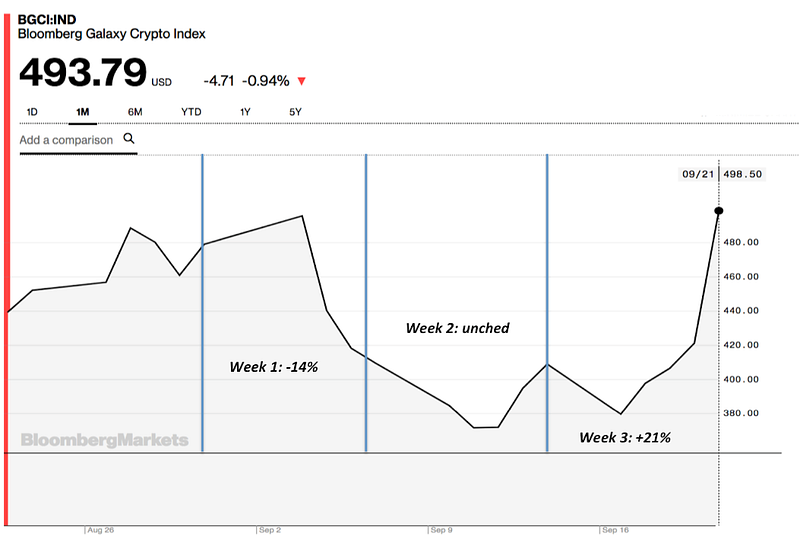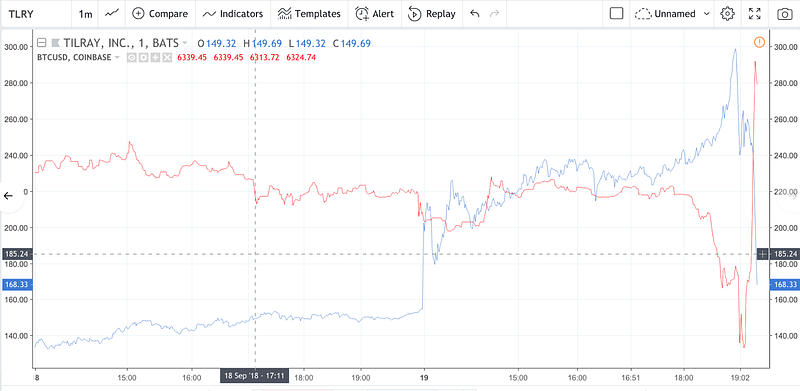What happened this week in the Crypto markets?
Walk away from the screens
There is one flaw with crypto markets remaining open 24/7/52 compared to traditional markets that only allow trading 5 days per week. Without a natural break, it’s difficult for investors to properly digest news. Most veteran market participants will admit that they need to take time away from their screens once in a while to fully absorb all of the inputs coming at them from a variety of directions, which allows them to process and look for viable outputs.
Take for example September’s price action thus far.
- The first week of the month began with huge gains for the first 4 days only to turn on a dime mid-week and end down (-14%) week-over-week.
- The second week of the month began with a huge selloff (-15–20%), only to turn on a dime and recover by week’s end to finish basically flat.
- This past week, the 3rd week of the month, began with a 7% drop on Monday — followed by a colossal “rip-a-thon” from Tuesday through Sunday, which sent the entire market higher (+20%) week-over-week.
Had you traded every day, you undoubtedly would have been caught up in the vortex. Had you picked entry points and exit points upfront, you probably had a pretty good week/month.
Price chart of the Bloomberg Galaxy Crypto Index — September 2018
Pent up positivity finally released thanks to Ripple (XRP)
We mentioned in last week’s Two Satoshis that almost ALL of the news two weeks ago was undeniable positive, and yet prices barely budged in crypto-land. Looking back however, all of the news was “non-security specific” — meaning, it was good for the overall crypto market but there was no one or two identifiable tokens for the market to latch on to and send higher. The tone was positive, but prices didn’t reflect the tone.
Last week that changed. Like a marathon runner coming out of the pack, Ripple (XRP) became the market darling following one announcement after another. Coupled with strength in more traditional markets, XRP was able to break the downward pricing spiral in crypto, setting the tone for a rally across the board not seen since June.
Breaking down week 3, day-by-day, you can see how a positive macro backdrop coupled with XRP’s news translated this pent-up positivity into higher prices:
- Monday — Asian, EM and US equities were all lower — as such, crypto prices shot down 7% in minutes while the VIX shot up +13%.
- Tuesday — Asian equities reversed course and shot up higher, and the crypto market ripped higher as well while the VIX fell -7%.
- Wednesday — All global markets traded higher except crypto in the morning … but following Crypto futures expiry and the XRP news (+25% itself), the whole market began its one-way march higher.
- Thursday — US markets were higher but Asia markets were down (mixed) — but XRP gapped up another 20% higher and the whole market followed suit.
- Friday — Asian equities ripped higher (+2–3%), XRP jumped almost 100% and anything not glued down in crypto land flew. XLM, ADA, LTC, NEO and many others saw 20–30% instant price gains on Friday and into the weekend.
It’s possible that crypto just needed a shot in the arm from Asian and EM equities, followed by Futures expiration that unwound in bullish fashion, to get the wheels in motion — but make no mistake about it, the rally was led by positive news.
The TLRY nonsense; why regulation alone isn’t enough
It’s been rumored that retail investors are now chasing cannabis stocks and forgetting about Bitcoin, given the 9-month old crypto bear market compared to relative strength in “pot stocks”. This “long cannabis/short BTC” strategy is hard to really quantify, but on Wednesday last week it was also hard to ignore. At 2:50 EST Wednesday, Tilray (TLRY) stock was halted after a run to $300 (+75 on the day), and the pop in BTC/USD happened right as TLRY reopened when the stock traded down $130 from the highs. This spurious, negative correlation strengthened the narrative, and can be seen in the charts.
Let’s forget about the correlation for a second, and focus on something more important. With the volatility and violent whipsaws experienced in crypto prices, many argue that crypto can never truly earn respect as an asset class until regulators steps in to monitor these violent price moves. While we concur that regulation is necessary, the rationale is faulty. Regulation alone does not prevent market manipulation nor does it protect investors from their own misbehavior. Just ask any retail investor who sold TLRY stock near the lows or bought near the highs. The stock was halted 5 times in one day, but that didn’t help anyone.
The Nasdaq is a regulated and respected Exchange in the US — but people are still people, and when they latch onto a stock that they think can make them rich overnight, bad things will happen. TRLY didn’t deserve a temporary $20 bn market cap any more than Tesla (TSLA) deserves its current $50 bn market cap. And a $20 bn market cap stock shouldn’t go up/down 50% in a day, but it did.
Regulation is important, but it’s not the most critical component of market health. There will always be traders who make bad decisions. And there will always be bad actors looking to trade on technicals rather than fundamentals. That doesn’t mean an entire asset class is bunk.
Peter Thiel is known as a very smart investor — his fund is the largest holder of TLRY stock. Thiel doesn’t trade it; he simply owns 76% of the shares. I don’t recall hearing anyone bashing him for having a stake in a volatile security. In fact, he’s applauded. It’s possible to have a long-term bullish view on an asset without being influenced by the market gyrations caused by others. Fundamental long-term holders of crypto should be offered the same respect without assuming that everyone is a day trader.
Notable Movers and Shakers
Just about every token and coin rose last week, with new leaders emerging each day from top alt-coins. While most remain a long-way away from their all-time highs, there were encouraging signs especially amidst the top 50 tokens (as measured by market cap).
- Ripple (XRP) had a breakout performance, rising 105% week-over-week after news surfaced that Ripple is launching a new XRP-backed product later this year, and followed that up two days later with more positive news that another top 10 bank, PNC, is becoming the latest to adopt Ripple’s xCurrent system.
- Stellar-Lumens (XLM) was the beneficiary of two promising pieces of news over the weekend; first that Goldman-Sachs backed financial platform, Circle, has added XLM to its array of investable assets. And second, that world aid organization UNICEF has expanded its breadth of donatable currencies to include Stellar (XLM). XLM tokens jumped higher on the news, and finished the week +35%.
- EOS fell 12% on Monday after news surfaced that two of the most popular apps in the EOS ecosystem fell victim to a hack. While this was not a security issue at EOS, nor was it even really a hack (more like a very smart player taking advantage of the game), it nevertheless highlighted the vulnerability and immaturity of platforms like EOS. That said, EOS recovered fairly quickly during the alt-coin rally later in the week, and finished the week 10% higher.
- Cardano (ADA) managed to gain 30% week-over-week, making it the 4th best performer last week amongst large-cap tokens. The rally followed a recommendation and analysis by Weiss Cryptocurrency Ratings saying that Cardano is a ‘steal’ at this price. XRP, XLM, EOS, Basic Attention Coin (BAT +8.0%), NEO (+8.0%), and MIOTA (+6.5%) were also mentioned positively by Weiss Ratings.
- Tezos (XTZ) cooled off a bit, only rising 3% week-over-week after gains of 30% the week before as anticipation grows surrounding its mainnet launch.
What We’re Reading this Week
We don’t necessarily agree with the PayPal short thesis, but this is a well balanced view on the rise and fall of single purpose fee-based technologies like Paypal that will be disrupted by cheaper, peer-to-peer blockchain protocols.
While this is “non-Blockchain” news, it shows a willingness of large corporations and specifically financial organizations to buck the trend a bit. IEX is shaking up the trading game, and one of the pioneers of electronic trading (Interactive Brokers) is the first to leave Nasdaq because of it. Note the heavy parallels to what we’re seeing with crypto adoption.
Bitcoin core developer Bryan Bishop, former Morgan Stanley MD Caitlin Long, and other prominent blockchain figures sent a letter to warn the SEC that enterprise adoption could actually corrupt some of bitcoin’s inherent benefits if not properly overseen.
The NYAG report not only released this important report on Crypto Exchanges, but kudos to them for also releasing a summary on Twitter. As part of the “Virtual Markets Integrity Initiative”, the NYAG office sent questionnaires to 13 crypto exchange platforms back in April, basically asking the target exchanges to provide details on how they deal with:
- Ownership & control
- Basic operation and fees
- Trading policies and procedures
- Outages and other suspensions of trading
- Internal controls
- Money laundering surveillance
- Protection against customer fraud
Arca in the Press & on the Streets
- Arca’s CIO Steven McClurg and Head of Research Katie Talati gave a detailed analysis of smart-contract Platform EOS via Crowdfund Insider. In the article, Talati argues that EOS may surpass Ethereum as the go-to “app store” for blockchain developers.
- McClurg was also quoted in this article from 51percent Crypto Research discussing the upcoming Bitcoin ETF proposal decisions. While the article takes a bullish stance on the inevitable approval (eventually), McClurg offered his rationale for why this process will continue to take time:
We caught up with Steven McClurg Chief Investment Officer of Arca Funds, on his thoughts on a potential approval.
The biggest issue the SEC has with a Bitcoin ETF is the low volume and lack of transparency around trading, which opens it up to market manipulation. We have seen manipulation occur not just in Bitcoin, but other cryptocurrencies. This is not a special case, as there is a precedent of the SEC limiting certain OTC-traded and micro-cap equities from inclusion in ETFs. It is unlikely that the SEC will approve an exchange-listed product such as an ETF to hold crypto currencies until the issue with market manipulation is solved.
And That’s Our Two Satoshis!
Thanks for reading everyone! Questions or comments, just let us know.
The Arca Portfolio Management Team
Jeff Dorman, CFA — Portfolio Manager
Katie Talati — Director of Research
Hassan Bassiri , CFA — Junior PM / Analyst
To learn more or talk to us about investing in digital assets and cryptocurrency
.jpg)


